by Jessica Routleff-Jones, Metals Conservator
The Victoria and Albert Museum is very fortunate to have an extensive collection of religious relics. One of these is the Cambridge Censer (M.123-1978, Figure 1), which is the earliest surviving example of a medieval base-metal church plate.1 Manufactured in England in about AD 1350, the substrate is an alloy of copper, zinc, and tin. The exterior surface is mercury-gilded to make it resemble more high-quality silver-gilt examples, such as the Ramsey Abbey Censer.
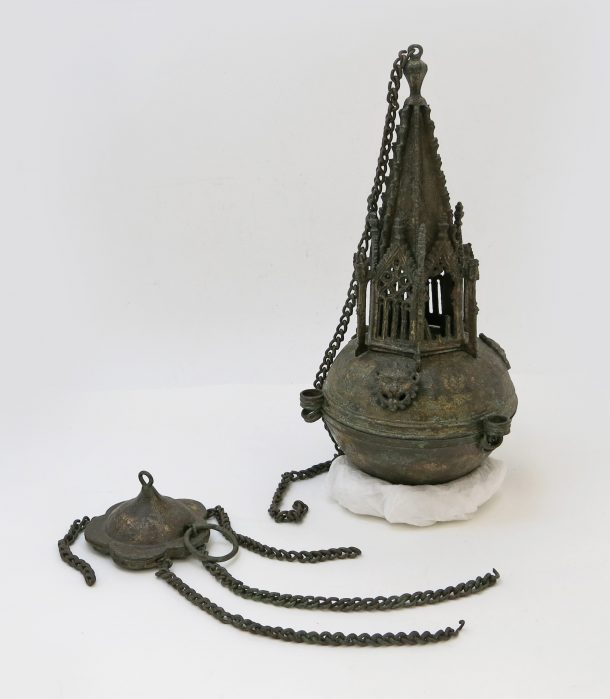
Censers are used in a religious setting to burn incense. The release of the smoke symbolises the prayers of the faithful rising to God. The bowl of the censer would have held hot coal combined with fragrances and gum arabic to produce the scented smoke, and in order to spread the scent the censer would have been swung from the chain by the priest. The design is characteristic of Gothic architecture and, like the Ramsey Abbey Censer, reflects the form and style of chapter houses. The bowl of the censer was raised into shape to create the deep centre in which to contain the incense and coal. The finer details, such as the windows and steeple, were cast and are intentionally “holey” to allow for the dispersal of the incense. The entire structure is attached through the top of the orb by two pillars, hidden inside the steeple. Prior to being gilded, the object would have looked much like it does today with its coppery hue.
From scientific analysis performed by the V&A, the precise composition of the alloys used to construct the different sections of the censer was revealed.2 This analysis confirms that the exterior of the surface was mercury gilded at manufacture. Certain areas of the gilding are better preserved than others, and trace elements of gold are still found on the surface despite not being visible to the naked eye. Mercury gilding is a process that was discovered during the middle ages; this process would metallurgically bond gold to the copper alloy surface. Having this information about the censer’s composition reveals a great deal about its original use. Roman Catholic churches required decorative altarpieces which were usually comprised of gold and silver, whereas less affluent church vessels were typically comprised of copper, brass or pewter. With this in mind, the Cambridge Censer likely heralds from a more modest place of worship.
The surface of the censer has significant losses and encrustations from a historic corrosion event. This can be attributed to the object being an archaeological find, rumoured to have been discovered in a ditch in Cambridge in 1977. These circumstances allowed for significant corrosion products to encrust on the surface which in turn caused the losses of the surface gilding. The object has previously been treated several times and likely underwent chemical treatment to remove the bulky corrosion products immediately following excavation. A historic photograph from a 1989 publication indicates that the highest surfaces of the censer suffered from active copper corrosion (Figure 2). At some point the corrosion was treated to stabilize the corrosion and reveal the surface.
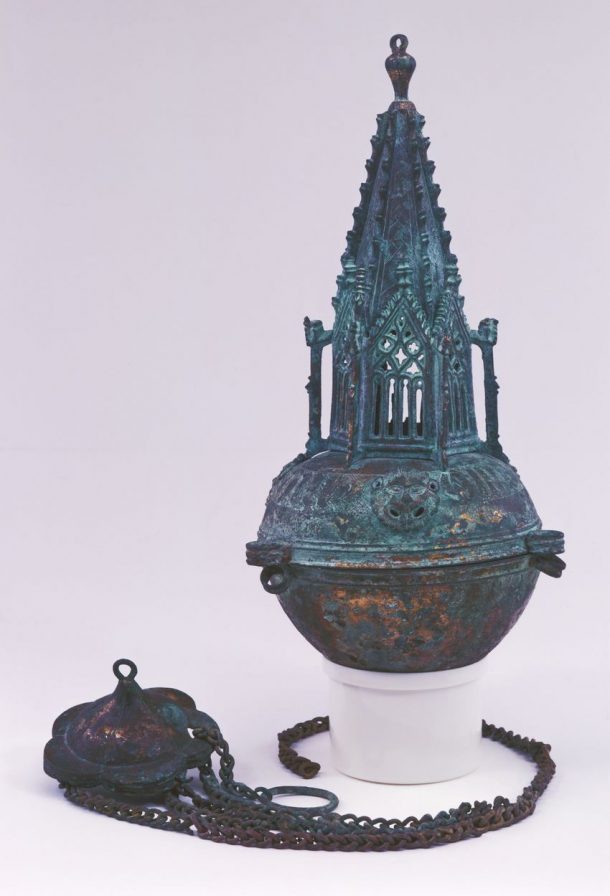
In the early 1990s and 2000s, the censer underwent cleaning and coating for display. Information gathered from conservation records indicates that the object was coated in Incralac to prevent further corrosion developing. Incralac is a commonly-used coating for copper alloys in the conservation industry. Comprised of benzotriazole, initially added as a UV stabilizer, it also has uses as a corrosion inhibitor, combined with Paraloid B44, an ethyl methacrylate and butyl acrylate copolymer.3 Unfortunately the Incralac had deteriorated and darkened due to its age, which is unsurprising as there are concerns that it can degrade and become insoluble over time.4 While one may mistake the darker colour of the coating as ‘wear’ to the gilding, it became evident following its removal that this barrier layer was altering the appearance of the surface (Figure 3). The use of Incralac over shiny surfaces, particularly gilding, can intensify UV degradation of the polymer due to the reflective nature of the metal.5
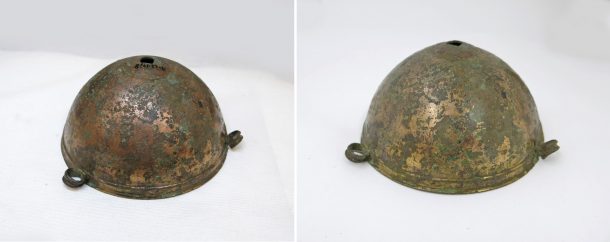
From a conservation perspective, it was necessary to remove the coating as the deterioration was not showcasing a true representation of the surface. The surface was cleaned of all coatings in an acetone bath; this was crucial to reach all of the nooks and crannies inside the steeple but it also minimized any need to unnecessarily abrade the surface using cotton swabs. The removal of the Incralac made an immediate difference as the surface of the object was revealed. Overall, the metal surface was brighter, as shown in Figure 4, with areas of stable copper corrosion suddenly visible as well as the bright lustre of the remaining gilding. In an effort to preserve the surface, the censer was coated in a thin layer of microcrystalline wax (Figure 5).
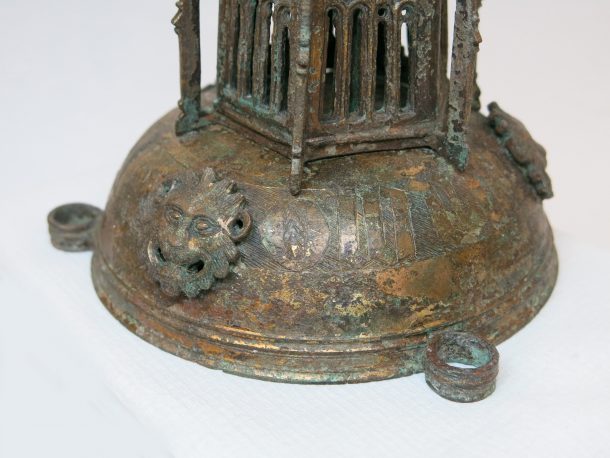
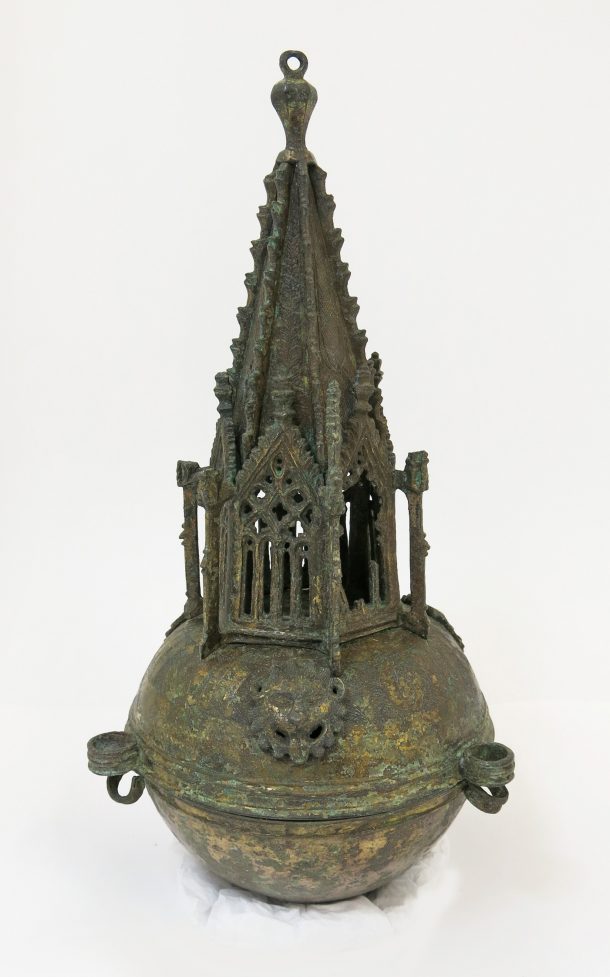
This treatment process serves as a reminder of the variable results that come from treating objects for long-term stability. When the coatings which had been chosen specifically to protect the surface began to degrade, they obscured key components on the object surface. Given the decorative nature of the censer, and the materials chosen for its manufacture, being sympathetic to its use and intended appearance was imperative. Ultimately, the revelation of beauty of the gilded surface was a delight. The Cambridge Censer will soon return to display in Sacred Silver and Stained Glass, Rooms 83 – 84, The Whiteley Galleries.
References
- Campbell, Marian, ‘The Cambridge Censer’ entry in R. W. Lightbrown et al, Metalwork Acquisitions at the Victoria and Albert Museum 1978-88, in The Bvrlington Magazine, 1989, vol. 131, no. 1034, p.386
- Martin. G., Analysis Report of The Cambridge Censer, Science Section, 1986
- Scott, David. A., Copper and Bronze in Art: Corrosion, Colourants, Conservation, The Getty Conservation Institute, 2002, p.384
- Ibid
- Ibid, p.385
Acknowledgements
Many thanks to Kirstin Kennedy, Curator, Sculpture, Metals, Ceramics & Glass, who shared her research and endless knowledge about the censer and the collection. I am also grateful to my colleagues Joanna Whalley, Senior Metals Conservator/Studio Manager, and Katrina Redman, Metals Conservator, for their willingness to share their knowledge and support.



Fantastic blog . I had no idea the censor had to have a acetone bath . I liked learning about the cleaning of the censor .